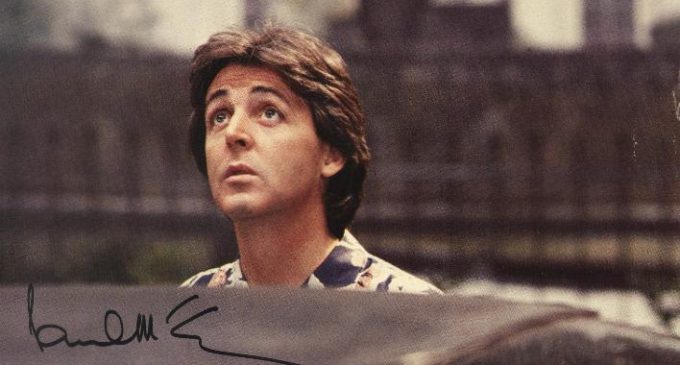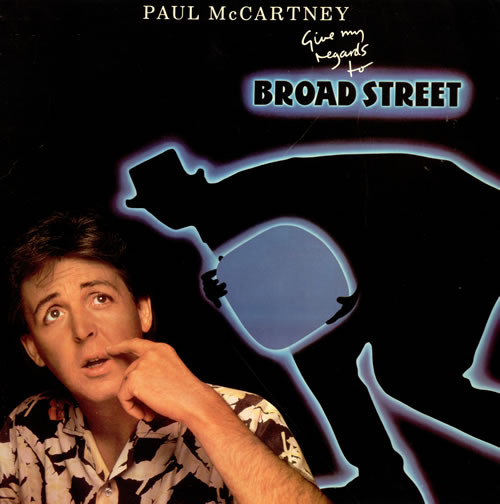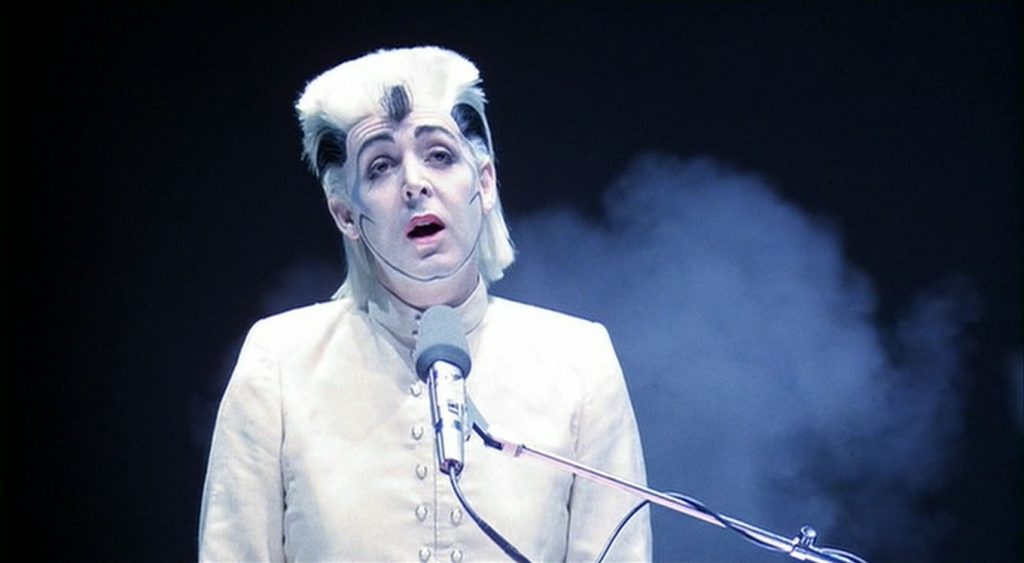Give My Regards To Broad Street

Give My Regards To Broad Street
By Bill Harry

He’d initially commissioned playwright Willie Russell to write a script, although Russell was to comment, “It was a nice idea and one it may be possible to resurrect at some point, “but I felt it wasn’t quite right for me at the time.”
Paul also had discussions with another playwright, Trevor Nunn, before finally deciding to write the script himself.
The idea for the plot came to him when his chauffeured car was held up in a traffic jam and he jotted down the idea on the spot. He’d remembered a story record producer Chris Thomas had told him about how an assistant had left the master tapes of the Sex Pistols ‘Never Mind the Bollocks’ on a station platform. He’d been due to take them to the factory and rushed back to the station to find that although the case had been soaked in the rainfall, the tapes were still intact and undamaged.
Paul said, “I thought just over three million dollars would see us through. In the first week alone, we’d spent nearly all that and I was ordering new cheque books.” He then realised he didn’t have to spend his own money and did a deal with 20th century Fox who provided funds of between $6 and $8 million.
Paul originally didn’t write a part for Linda in ‘Give My Regards to Broad Street’, but added one for her after she’d protested to him about it.
The film was two years in the planning and pre-production. Shooting eventually began in August 1982, and lasted for twenty-eight weeks. When it opened in 1984, the film was given a number of premiers. The American one was held at the Egyptian Theater, Los Angeles, on October 22 with a special party at the Bistro Club. The New York premier at the Gotham Theater was followed with a party at Club A. The Liverpool premier took place at the Odeon cinema on November 28 and Paul was presented with the Freedom of the City at a special ceremony earlier in the day. The London premier took place at the Empire Leicester Square, on November 29, with a pre-premier party at the Hippodrome.
Paul became involved in major promotion for the film in both America and Britain and travelled to the US early in October 1984 for three weeks to promote it, appearing on shows such as ‘Good Morning America’ and ‘The Johnny Carson Show’.
In Britain he appeared for one hour on a ‘South Bank Show’ special, on the chart show ‘Harty’ and on Film ’84.
As mentioned, Paul had originally intended using the finances of his MPL company, but 20th Century Fox stepped in with funding in exchange for worldwide distribution rights.
When it opened in 311 cinemas across America, it was savagely panned by the critics and was an initial box office disappointment. The show business magazine ‘Variety’ described it as: “Characterless, bloodless and pointless”.
Paul commented, “I wanted to make the sort of movie that I like to see. It’s an old-fashioned musical, a good night out, nothing heavy. Like most people, I go to the cinema to be entertained, not to see my own problems on the screen”.
George Martin was drafted in to work on the arrangements and also to appear as himself. The musicians who were featured included Dave Edmunds, Chris Spedding, John Paul Jones, Eric Stewart, Steve Lukather, Jeff Porcaro, Jody Linscott, Louis Johnson, Dave Gilmour, Dave Mattocks and Herbie Flowers.
Songs featured were: ‘Good Day Sunshine’, ‘Here, There and Everywhere’, ‘Wanderlust’, ‘No More Lonely Nights’, ‘Ballroom Dancing’, ‘Silly Love Songs’, ‘Not Such a Bad Boy’, ‘So Bad’, ‘No Values’, ‘For No One’, ‘Eleanor Rigby’, ‘Band on the Run’, Zip-A-Dee-Doo-Dah’, Bless ‘Em All’, ‘Give My Regards To Broad Street’ and ‘Sleepy Lagoon’.
Prominent among the cast were Sir Ralph Richardson, Tracey Ullman, Bryan Brown and the wrestler ‘Giant Haystacks’. Peter Webb was the director.

Steve estimates that the missing tapes are worth five or six million pounds and Paul sets off with him to a recording studio, dismissing Steve’s fears that Harry may have absconded with the tapes to bootleg them.
At the studio Paul tells Ringo Starr and George Martin about the missing tapes and then goes to Elstree Studios where he joins Linda and the band to record the ‘Ballroom Dancing’ sequence. After a short break in the studio canteen it’s off to the make-up room to apply a futuristic look for the ‘Silly Love Songs’ scene, and then the search for Harry and the missing tapes continues. Paul later fits in some rehearsals in a warehouse before setting off to the BBC for an interview.
During a rendition of ‘Eleanor Rigby’ we are taken back to Victorian times as Paul, Linda, Ringo and Barbara Bach picnic on a river bank. Another scene is Dickensian as Harry is pursued by a giant figure with a bull terrier (shades of Bill Sykes!) and is eventually stabbed by Rath.
The visions fade and Paul makes his way to visit the Old Justice, an East End pub where Harry had been spotted the previous evening. He chats to Jim, the landlord and then drives into central London as the deadline for the takeover nears. Paul comes to Broad Street Station and remembers that Harry had mentioned the station when he’d left with the tapes. Paul wanders along the deserted platform and discovers Harry, who had been accidentally locked inside a hut. Paul is able to return to his office with the tapes in time to beat the deadline of the Rath takeover.
Commenting on the ‘Ballroom Dancing’ sequence, Paul said: “I wanted to do it in either Hammersmith Palais or the Lyceum, but the director said that the reason they don’t like doing that in films is that if the lighting man suddenly says, ‘Take that wall out’, it’s alright on a set, but you could imagine the manager of the Hammersmith Palais being a bit upset!
“It was great that, we had the band on stage – John Paul Jones on bass, Ringo on drums, Dave Edmunds and Chris Spedding on guitars, Linda and me on piano, so we had that element, which was nice enough anyway. We had the back up guys, who were like the Palais band, then we had the dancers. All the formation dancers, three specialist dancers, then we had another back up of young dancers, who were like the rock ‘n’ roll kids. One of the couples were the people who won our Buddy Holly competition, the guy who had been on the dole in Liverpool until then. So, all of these elements, pulling them together, and still trying to have a laugh. I think that works really well in the film.”
Written by: Bill Harry ©2017. All rights reserved. No unauthorised copying or re-publishing of this material is allowed by law. Please contact the writer for re-print permission.
(Contributor, McCartney Times)



There are no comments at the moment, do you want to add one?
Write a comment